Things You'll Need
Fresh mussels (or frozen mussels that were cooked before freezing)
Virgin Olive Oil
Garlic
Salt
Pepper
Saucepan with lid
Container with locking lid
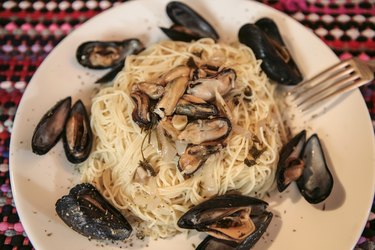
Shellfish are a nutritious seafood that can easily be incorporated into just about any meal. Anyone who has ever tasted perfectly-prepared mussels over linguine or in a seafood gumbo can attest to their delightful flavor and delicate texture. Finding a reliable source of fresh mussels can be a challenge, however, for those landlocked fans of the sweet shellfish, so using frozen mussels can help keep them on your table all year. Some preparation is needed to ensure safety and quality, but anyone with a saucepan with a lid can prepare fresh mussels for freezing or thaw frozen mussels for a nice home-cooked meal.
How to freeze mussels safely
Step 1
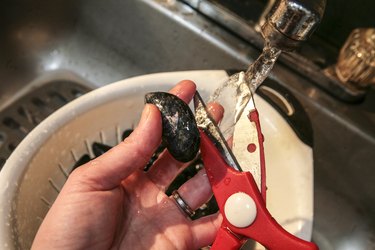
Rinse fresh mussels in their shells under cool running water, removing any remnants of seaweed or other brushy growth (called the "beard"). Cut off any fibrous threads attached to the lips of the mussels with a pair of kitchen scissors.
Video of the Day
Step 2

Heat a sauce pan over medium-high heat with a few tablespoons of virgin olive oil. Add chopped onions and saute for a few minutes until the onions becomes translucent. Add four or five cloves of minced garlic, a cup of white wine, 1/4 cup of chopped parsley, and a pinch each of salt and pepper to taste.
Step 3
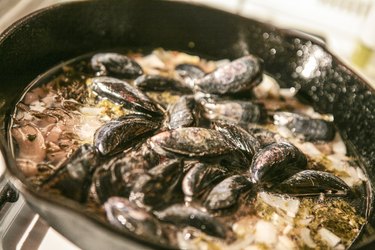
Add the freshly-cleaned mussels to the sauce pan, then cover the pan with a tight lid and shake the pan vigorously to spread the ingredients around and mix them.
Step 4

Allow the mussels to steam in the sealed sauce pan for two to three minutes. Check to make sure the mussels have fully opened, which indicates they are done, and steam another minute or so if they remain sealed. Do not cook for longer than about three minutes to keep the mussels tender and juicy.
Step 5
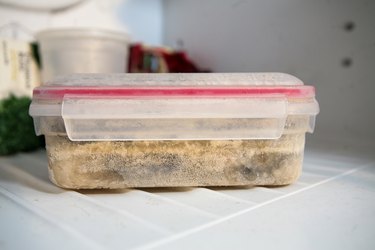
Pour the entire contents of the sauce pan, including all the liquid and oils, into an air-tight container that can be sealed tightly. Pick out the mussels and remove the meat from their shells with a quick flick of a sharp blade, then discard the shell and return the mussel meat back to the broth from whence it came. Place the container of mussels into a freezer for three to four months.
How to cook frozen mussels
Step 1
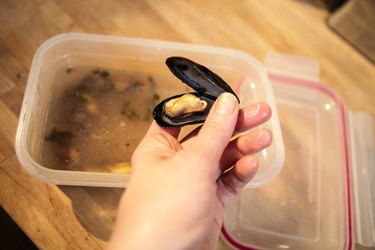
Make sure the frozen mussels you are about to use were fully-cooked before you thaw them. Do not use mussels that were frozen raw.
Step 2
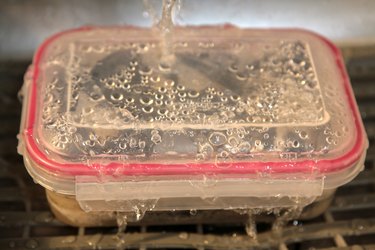
Allow the frozen mussels to thaw overnight in the refrigerator in a container with a sealed lid. Run warm water over a container of frozen mussels if time is of the essence, however gently thawing them out in the refrigerator yields more tender results.
Step 3
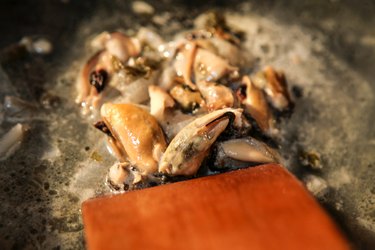
Heat frozen mussel meat in a sauce pan once fully thawed, then eat them as is or add to other recipes, such as spaghetti sauce or soup.
Step 4
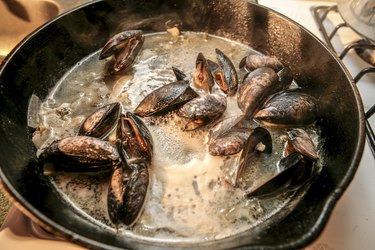
Steam frozen mussels still in the shell for three or four minutes in a covered saucepan over medium-high heat with butter, garlic, and a tablespoon of extra virgin olive oil, then reduce the heat and simmer for a few minutes longer. The shells should open; discard any that remain closed.
Tip
Store fresh mussels in your refrigerator for as long as eight days, keeping them moist with a wet cloth so they can remain alive until you are just about to prepare them. Mussels still in their tightly-closed shells can be prepared for freezing by simply blanching them in rapidly boiling water for 30 seconds, but cooking them completely before freezing is the preferred methods to ensure safety and convenience.
Warning
Do not use fresh mussels that have died, as you cannot ensure their freshness. Tap on a slightly opened mussel to ensure the shells closes, which indicates the mussel is still alive. Discard mussels that no longer move when prodded.
Video of the Day